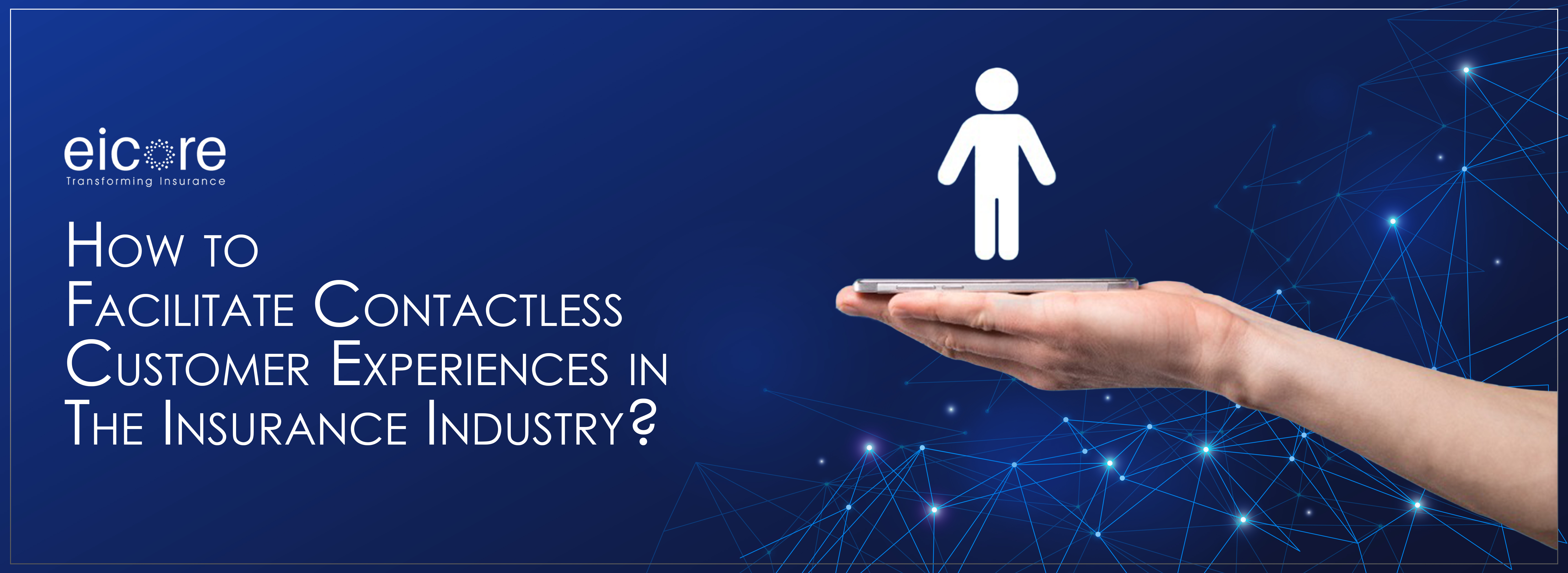
How to Facilitate Contactless Customer Experiences in the Insurance Industry?
By: Eicore Technologies | Tuesday, 28 December 2021
Due to the emergence of the COVID-19 pandemic, it has become imperative to reimagine the customer experience while preparing for a truly ‘contactless’ world. And this is something that will continue to remain even after the pandemic.
However, the current COVID-19 situation is undeniably responsible for making the insurance sector introspect and plan for a future-proof business that would firmly stand against any unexpected system disruptions. Thus, almost all insurers underwent massive end-to-end digitalization to recreate their business models and product offerings while facilitating contactless customer experiences.
So, let’s see how hi-tech contactless systems will contribute to customer experience in the insurance sector.
 Integration of advanced technologies in existing insurance infrastructure
Integration of advanced technologies in existing insurance infrastructure
When a purpose-driven approach is used to cater to customers' evolving expectations, it induces customer loyalty. And for doing so, you must opt for digital solutions and make the best use of cloud-stored customer data to enhance such operational experiences.
The implementation of Artificial Intelligence and Machine Learning has already gained worldwide popularity, and the insurance industry is not of any exception. Hence, the integration of AI and ML algorithms into the existing infrastructures of insurers helps them to a great extent. The way these systems process a pool of data and learn on their own to make effective decisions is a key to establishing personalized contactless experiences.
Moreover, insurers can deploy Cloud for storing customer-generated data, which AI-driven systems can easily collect for better data processing. Also, as data remains well-organized in Cloud, there's no need for intensive paperwork or physical labour. Instead, insurers can access the data online with a few clicks and facilitate a contactless customer experience based on their data insights.
Thus, with more customers looking for a personalized experience before and after buying insurance, insurers have integrated AI and ML algorithms and deployed cloud servers in their existing systems to meet those demands.
 Adoption of self-service claims portal for hassle-free claims processing
Adoption of self-service claims portal for hassle-free claims processing
By following the traditional way of inspection, even the simplest claims will take at least 5 working days. Soon after a claim settlement request is raised by a policyholder to the insurer, a surveyor will be assigned to visit the site, assess the extent of loss or damage caused, process all claim-related documents, and based on that, sanction the claim.
It is evident that the entire procedure of manual claims processing is time-consuming and error-prone. So, this is where a self-service claims portal can come of great help. It facilitates customer registration, inspection, and settlement of their insurance claims in a short time.
Using the technology of Computer Vision and Cloud, policyholders themselves can capture the damage with their smartphone’s camera and upload it to the system for better analysis and effective decision-making. After that, the AI-integrated systems will automatically review the claim request, analyze the images by collecting them from the Cloud, and then verify the policy details.
If the claim request passes the AI algorithm, the system will send wire instructions to the bank to facilitate claim disbursement. Thus, self-service portals can effortlessly perform risk assessment, automate claims, and prevent dubious claims without manual intervention or intense labour. This, in turn, reduces the turnaround time for claim settlement and eliminates human-made errors. Also, as per reports, automation of processes can reduce the expense of a claims journey by 30% in the short term, leveraging the growth of insurance companies and facilitating enhanced digital customer experiences.
 Inclusion of responsive mobile applications and chatbots
Inclusion of responsive mobile applications and chatbots
With the emergence of advanced technologies and their adoption by almost all sectors, customers have become tech-savvy and want a contactless experience. Thus, the new-generation techie consumers do not prefer the traditional manual insurance selling method. Also, due to the COVID-19 pandemic, people who previously prioritized face-to-face communication while purchasing an insurance policy is now reluctant to meet people.
In such a scenario, chatbots and mobile apps became predominant channels for insurance services. Whether consumers need consultation on the right insurance policy or want to file claims, all can be done only through a few clicks.
Nowadays, most insurance companies have their own enterprise mobile apps, which policyholders can easily access to perform all insurance-related tasks right at their home’s comfort. For instance, they can pay their policy premiums, renew their policies, or ask about their insurance on these apps. Besides, there are also vernacular or multilingual chatbots that can handle all customer queries related to pre and post insurance sales.
Thus, virtual bots and responsive mobile apps help customers take more uniform decisions without meeting insurers personally while executing a contactless mode of communication. It allows customers to feel empowered and makes them stay virtually connected to the brand, leading to a seamless customer experience.
 Wrap Up
Wrap Up
To finally conclude, the thing that only counts in the entire journey is how experiences connect with customers. A purpose-oriented engagement, personalized choices, and a reimagined journey will create a huge difference. Thus, an action-based strategy coupled with advanced technologies and optimum digital solutions will drive purpose-driven outcomes, adding value to contactless customer experiences.